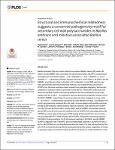Structural and immunochemical relatedness suggests a conserved pathogenicity motif for secondary cell wall polysaccharides in Bacillus anthracis and infection-associated Bacillus cereus
Kamal, Nazia
Ganguly, Jhuma
Saile, Elke
Klee, Silke
Hoffmaster, Alex
Carlson, Russell W.
Forsberg, Lennart S.
Kannenberg, Elmar L.
Quinn, Conrad P.
Bacillus anthracis (Ba) and human infection-associated Bacillus cereus (Bc) strains Bc G9241 and Bc 03BB87 have secondary cell wall polysaccharides (SCWPs) comprising an aminoglycosyl trisaccharide repeat: →4)-β-d-ManpNAc-(1→4)-β-d-GlcpNAc-(1→6)-α-d-GlcpNAc-(1→, substituted at GlcNAc residues with both α- and β-Galp. In Bc G9241 and Bc 03BB87, an additional α-Galp is attached to O-3 of ManNAc. Using NMR spectroscopy, mass spectrometry and immunochemical methods, we compared these structures to SCWPs from Bc biovar anthracis strains isolated from great apes displaying “anthrax-like” symptoms in Cameroon (Bc CA) and Côte d’Ivoire (Bc CI). The SCWPs of Bc CA/CI contained the identical HexNAc trisaccharide backbone and Gal modifications found in Ba, together with the α-Gal-(1→3) substitution observed previously at ManNAc residues only in Bc G9241/03BB87. Interestingly, the great ape derived strains displayed a unique α-Gal-(1→3)-α-Gal-(1→3) disaccharide substitution at some ManNAc residues, a modification not found in any previously examined Ba or Bc strain. Immuno-analysis with specific polyclonal anti-Ba SCWP antiserum demonstrated a reactivity hierarchy: high reactivity with SCWPs from Ba 7702 and Ba Sterne 34F2, and Bc G9241 and Bc 03BB87; intermediate reactivity with SCWPs from Bc CI/CA; and low reactivity with the SCWPs from structurally distinct Ba CDC684 (a unique strain producing an SCWP lacking all Gal substitutions) and non-infection-associated Bc ATCC10987 and Bc 14579 SCWPs. Ba-specific monoclonal antibody EAII-6G6-2-3 demonstrated a 10–20 fold reduced reactivity to Bc G9241 and Bc 03BB87 SCWPs compared to Ba 7702/34F2, and low/undetectable reactivity to SCWPs from Bc CI, Bc CA, Ba CDC684, and non-infection-associated Bc strains. Our data indicate that the HexNAc motif is conserved among infection-associated Ba and Bc isolates (regardless of human or great ape origin), and that the number, positions and structures of Gal substitutions confer unique antigenic properties. The conservation of this structural motif could open a new diagnostic route in detection of pathogenic Bc strains.
Dateien zu dieser Publikation
Keine Lizenzangabe

